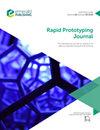材料挤压增材制造中的稳定熔化
IF 3.6
4区 工程技术
Q1 ENGINEERING, MECHANICAL
引用次数: 0
摘要
材料挤压(MatEx)增材制造中缺陷的主要原因是热端非等温条件,导致挤压和聚合物焊接不一致。本文旨在验证一种定制的热端设计,该设计旨在加热热塑性塑料,使其在喷嘴之前形成熔体,并减少熔体温度的变化。还提出了热端完整的三维温度验证方法。设计/方法/方法不同体积流量、热端温度设定值和喷嘴孔直径的稳态挤出红外(IR)热成像为模型验证提供了数据。采用有限元模型对挤出物的温度进行了预测。模型调整说明了不同的模型假设对模拟熔体温度的影响。实验结果表明,测得的温度和方差是体积流量、温度设定值和喷嘴孔径的函数。对周围空气的对流是主要的传热机制。自定义热端使熔体在进入喷嘴之前达到其设定点温度。独创性/价值这项工作为各种参数设置提供了一套完整的稳态红外热成像数据。它还提供了对定制热端性能的洞察,旨在提高MatEx熔化的稳稳性。最后,本文提出了一种将金属部件和系统周围空气结合在一起的系统建模策略。本文章由计算机程序翻译,如有差异,请以英文原文为准。
Steady melting in material extrusion additive manufacturing
Purpose
A main cause of defects within material extrusion (MatEx) additive manufacturing is the nonisothermal condition in the hot end, which causes inconsistent extrusion and polymer welding. This paper aims to validate a custom hot end design intended to heat the thermoplastic to form a melt prior to the nozzle and to reduce variability in melt temperature. A full 3D temperature verification methodology for hot ends is also presented.
Design/methodology/approach
Infrared (IR) thermography of steady-state extrusion for varying volumetric flow rates, hot end temperature setpoints and nozzle orifice diameters provides data for model validation. A finite-element model is used to predict the temperature of the extrudate. Model tuning demonstrates the effects of different model assumptions on the simulated melt temperature.
Findings
The experimental results show that the measured temperature and variance are functions of volumetric flow rate, temperature setpoint and the nozzle orifice diameter. Convection to the surrounding air is a primary heat transfer mechanism. The custom hot end brings the melt to its setpoint temperature prior to entering the nozzle.
Originality/value
This work provides a full set of steady-state IR thermography data for various parameter settings. It also provides insight into the performance of a custom hot end designed to improve the robustness of melting in MatEx. Finally, it proposes a strategy for modeling such systems that incorporates the metal components and the air around the system.
求助全文
通过发布文献求助,成功后即可免费获取论文全文。
去求助
来源期刊

Rapid Prototyping Journal
工程技术-材料科学:综合
CiteScore
8.30
自引率
10.30%
发文量
137
审稿时长
4.6 months
期刊介绍:
Rapid Prototyping Journal concentrates on development in a manufacturing environment but covers applications in other areas, such as medicine and construction. All papers published in this field are scattered over a wide range of international publications, none of which actually specializes in this particular discipline, this journal is a vital resource for anyone involved in additive manufacturing. It draws together important refereed papers on all aspects of AM from distinguished sources all over the world, to give a truly international perspective on this dynamic and exciting area.
-Benchmarking – certification and qualification in AM-
Mass customisation in AM-
Design for AM-
Materials aspects-
Reviews of processes/applications-
CAD and other software aspects-
Enhancement of existing processes-
Integration with design process-
Management implications-
New AM processes-
Novel applications of AM parts-
AM for tooling-
Medical applications-
Reverse engineering in relation to AM-
Additive & Subtractive hybrid manufacturing-
Industrialisation
 求助内容:
求助内容: 应助结果提醒方式:
应助结果提醒方式:


